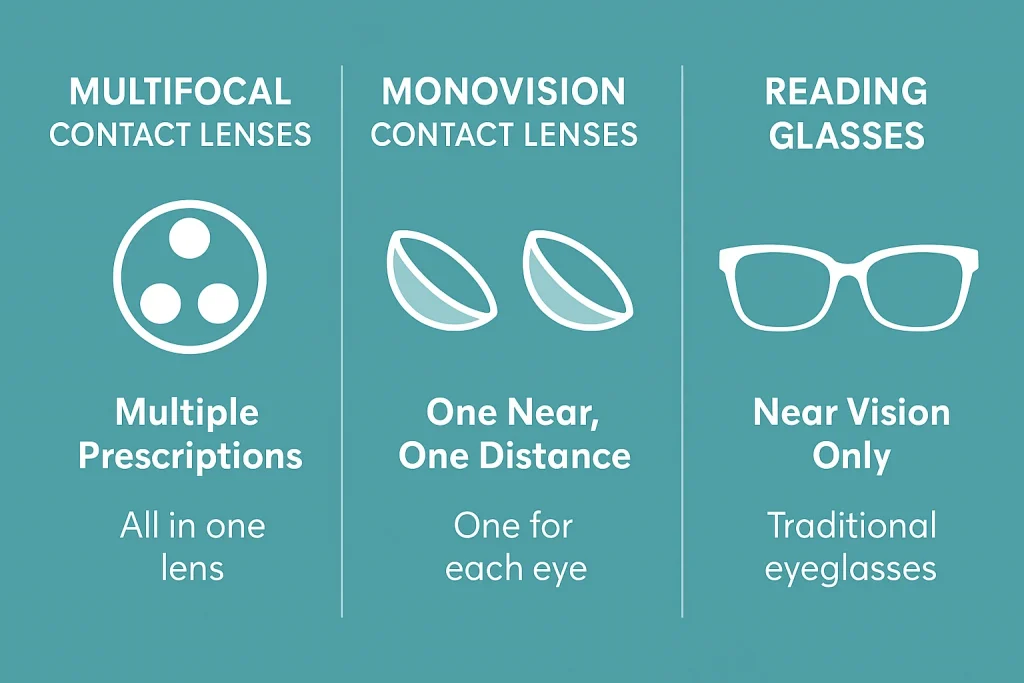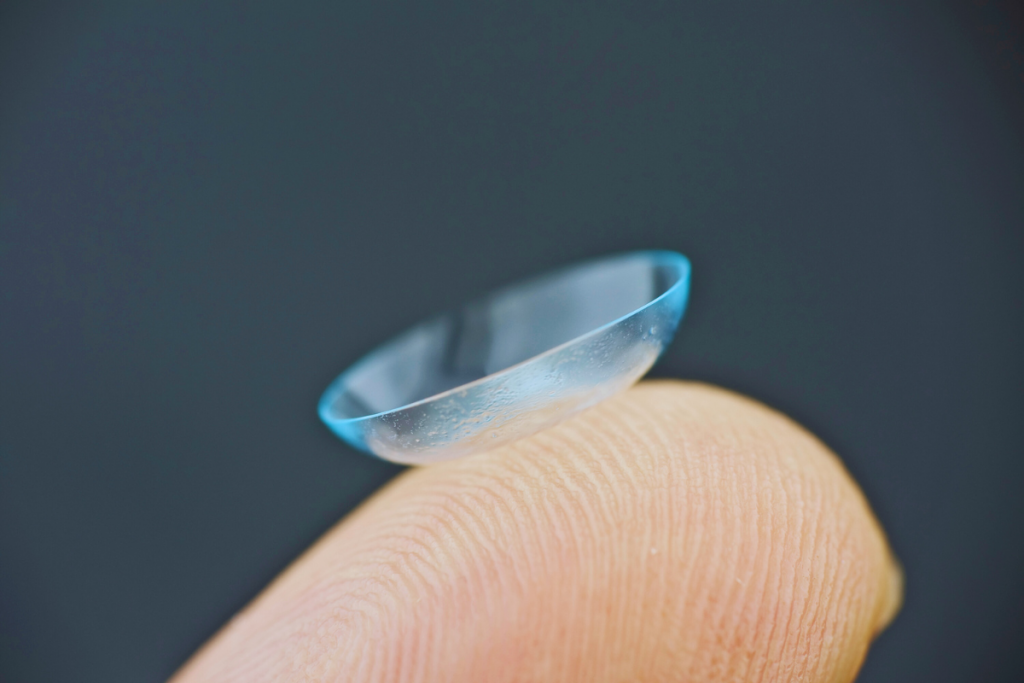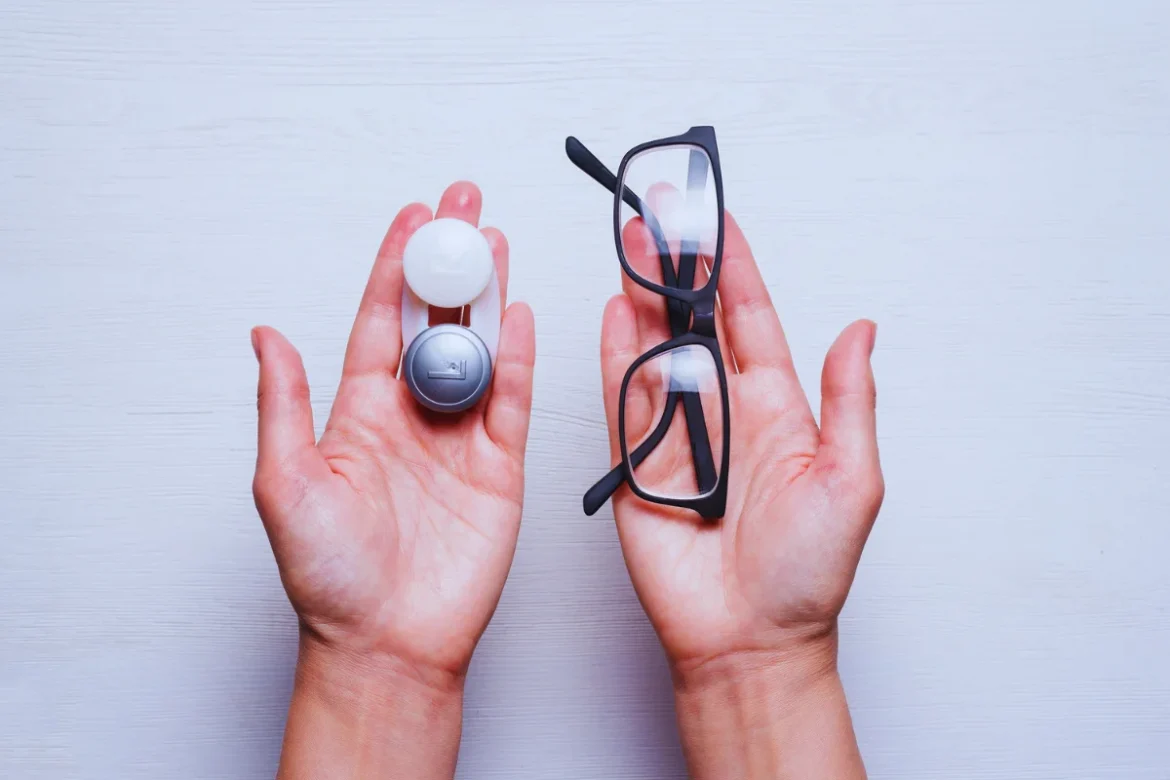Are you starting to struggle to read small text on your phone, books or menus? You’re not alone.
Many people notice these changes in their vision as they get older and start looking for better solutions. One common question that comes up is: Can I get contact lenses for reading?
Reading glasses have been the traditional go-to for near vision correction but not everyone finds them convenient or comfortable.
With today’s advancements in eye care more people are looking into contact lenses as a hands-free alternative. Whether it’s for convenience, aesthetics or lifestyle the interest in using contacts instead of reading glasses is growing.
This blog will help you understand if contact lenses are a good option for reading. We’ll cover how vision changes with age, what types of contact lenses are available and what to expect if you decide to try them.
What Is Presbyopia and Why It Affects Reading Vision?
Presbyopia is a natural part of the aging process that affects your ability to focus on nearby objects. It usually starts to become noticeable in your early to mid-40s even if you’ve never had vision problems before.
As we age the lens inside the eye becomes less flexible. This makes it harder for the eyes to switch focus from far to near.

As a result everyday tasks like reading a book, checking your phone or viewing a menu at a restaurant can become frustrating. You might find yourself holding things farther away, squinting more often or experiencing eye strain.
Some common symptoms of presbyopia include:
- Blurry vision when reading up close
- Needing brighter lighting to see clearly
- Eye fatigue after doing close-up tasks
- Frequent headaches after reading or computer work
Presbyopia can’t be prevented but it can be managed effectively with the right vision correction. And contact lenses are one of the flexible solutions available.
Can Contact Lenses Help with Reading?
Yes, contact lenses can help you see clearly when reading or doing other close-up tasks. Thanks to modern lens technology, there are several options designed specifically for people who need help with near vision.
Unlike traditional reading glasses which you wear only when needed contact lenses are worn directly on the eye and correct your vision all day.
You don’t have to put them on and take them off which makes them more convenient for people with busy or active lifestyles.
Types of Contact Lenses for Reading

Thinking of switching to contact lenses to help with reading? You’ll be happy to know there are a few different types designed just for that.
Each works a little differently so finding the right one depends on your eyes, comfort level and how you use your vision day-to-day.
Multifocal Contact Lenses
Multifocal contact lenses have multiple prescription zones built into one lens. That means you can see clearly up close, middle and far without having to switch glasses.
Think of it like having different focus points blended into the lens.
When you look through them your eyes naturally pick the area of the lens that gives you the sharpest view for what you’re doing, whether you’re reading, using your phone or driving.
They come in soft lenses (which are flexible and comfortable) and rigid gas-permeable lenses (which provide sharper vision but may take time to get used to).
Why people like multifocal lenses:
- You don’t have to switch between reading and distance glasses
- Great for all day wear
- Offers a more natural vision experience once your eyes adjust
Monovision Contact Lenses
Monovision is a different approach. With this setup one eye wears a lens for distance vision and the other eye wears a lens for close up tasks like reading.
It may sound strange but your brain actually learns to adapt and use the right eye for the right task.
At first it may feel a bit off—but many people adjust quickly and love the simplicity.
Pros of monovision:
- Usually less expensive than multifocal lenses
- Simple to try during a contact lens fitting
- Works well for people who don’t need sharp vision at every distance
Cons to consider:
- Some people notice a slight loss of depth perception
- May not be ideal for activities like night driving or sports
Modified Monovision
Modified monovision is a mix of the two above. One eye gets a multifocal lens (for seeing at all distances) and the other eye uses a regular lens just for distance vision.
It offers a balance between clear vision and comfort especially for people who find full monovision a little tricky but don’t fully adjust to multifocal lenses either.
Eye Protection Glasses for Mobile and Computer
Tips for Adapting to Reading Contact Lenses
Reading contact lenses can feel like a big change if you’ve been wearing reading glasses for a long time. But with a bit of time and the right habits your eyes will adjust. Here’s how.

Be patient as your eyes adjust
It’s completely normal to go through an adjustment period. Your brain and eyes are learning to work together in a new way. Some people feel comfortable in just a few days, while others may need a couple of weeks.
Start with short reading sessions
Try using your new lenses for easy tasks first. Read a book or check your phone for a few minutes at a time. Gradually increase the time as your eyes get more comfortable.
Remember to blink often and keep your eyes hydrated
Blinking helps keep your lenses moist and your vision clear. If your eyes feel dry or tired, use lubricating eye drops that are safe for contact lens wearers. Keeping your eyes comfortable makes a big difference.
Try not to switch back and forth between glasses and lenses
Switching between your old glasses and new contact lenses can confuse your vision and slow down the adjustment. Try to stick with your lenses throughout the day so your eyes can fully adapt.
Top Rated Contact Lenses in Dubai
Things to Consider Before Switching
Before you switch out your reading glasses for contact lenses, weigh a few practical things. While contact lenses are convenient and free, they come with responsibilities and considerations that can impact your comfort and lifestyle.
Cost vs Reading Glasses
Reading glasses are cheaper and easier to replace. You can grab a pair off the counter for a few bucks.
Contact lenses require a prescription, follow up visits and a steady supply especially if you’re using daily disposables or premium multifocal lenses. Keep in mind the type of lens and how often you wear them will affect the total cost over time.
Lens Care and Maintenance
Unlike glasses, contact lenses need daily care to keep your eyes healthy. If you’re using reusable lenses you’ll need to clean and store them properly with a lens solution.
Neglecting care routines can lead to discomfort or even infections. Daily disposables are easier to manage but still require clean hands and good hygiene practices.
Prescription Updates and Regular Eye Exams
Your vision can change over time, especially if you have age related conditions like presbyopia. That’s why it’s important to schedule regular eye exams. Your optometrist can make sure your contact lenses still meet your needs and check for any issues with lens fit or eye health.
Digital Screens and Lighting
If you spend a lot of time on digital screens, tell your eye care provider. Some people experience dry eyes or glare sensitivity when using contacts while working on computers or phones.
You might benefit from lenses designed for screen use or using artificial tears during the day. Lighting also plays a role; using good ambient light while reading or working helps reduce eye strain.
Conclusion
Contact lenses can be a great option for reading and near vision. They’re convenient and free that many people love compared to traditional reading glasses.
Choosing the right type of contact lenses depends on your individual eyes, daily activities and how you feel wearing them.
Talk to your eye care professional to find the best option for you. They can guide you through the choices and make sure you get a good fit for clear comfortable vision.
Frequently Asked Questions (FAQs)
Can contact lenses help with reading?
Yes. Special contact lenses like multifocal or monovision lenses are designed to help people see clearly at close distances, making reading easier without needing separate reading glasses.
What are multifocal contact lenses?
Multifocal lenses have different prescription zones for near, intermediate, and distance vision. They allow your eyes to focus naturally at various distances without switching glasses.
How does monovision work for reading?
Monovision fits one eye with a lens for distance vision and the other for near vision. Your brain adjusts by using each eye for different tasks, which helps with reading and seeing far.
Are reading contact lenses comfortable to wear?
Most users find them comfortable, but there may be an adjustment period. Proper fitting and following your eye care professional’s advice will improve comfort.
Can I wear reading contact lenses all day?
Yes, depending on the lens type and your eye health. Some people wear them all day, while others use them mainly for reading or close work.
Do I still need reading glasses if I wear contact lenses?
Sometimes. Some people use contact lenses for distance and still prefer reading glasses for very small print or prolonged reading.
Can contact lenses correct astigmatism and presbyopia at the same time?
Yes, specialized toric multifocal lenses can correct both conditions, but you will need a prescription and fitting from an eye care professional.


